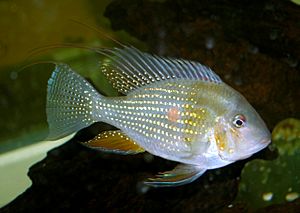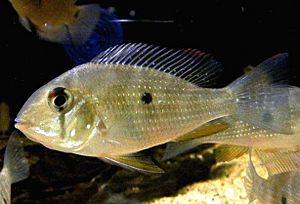Threadfin acara facts for kids
Quick facts for kids Threadfin acara |
|
|---|---|
 |
|
| adult | |
| Scientific classification | |
| Synonyms | |
|
The threadfin acara (Acarichthys heckelii) is a cool fish from South America. It's a type of cichlid fish, known for being smart and having interesting behaviors. This fish is the only one in its group, called Acarichthys. You can find it in rivers in the Amazon and Essequibo areas. Sometimes, people keep them as pets in aquariums.
Contents
What's in a Name?
The threadfin acara was first described in 1848. Two German scientists, J. P. Müller and Troschel, gave it the name Acara heckelii. Later, in 1912, another scientist named Eigenmann put it into its own special group, Acarichthys.
The "heckelii" part of its name honors a fish expert named Johann Jakob Heckel. He was the director of a museum in Vienna and studied many fish. The common name "threadfin acara" comes from its dorsal fin. This fin has long, thin rays that look like threads.
What Does It Look Like?
This fish has a body that is flat on the sides and quite tall. Its upper body is brownish-silver, and its sides are shiny silver. Its belly is a light color.
You might notice a black line under its eye. There's also a black spot on the front part of its dorsal fin. Another small black spot can be seen on its side, right below the middle of its dorsal fin.
Where Does It Live?
The threadfin acara naturally lives in the Amazon and Essequibo river basins in warm parts of South America. But it has also been found in places like Singapore and other parts of Southeast Asia. This probably happened because some fish escaped from fish farms or aquariums. It's one of about ten types of South American cichlids that now live in Asia.
How Does It Live and Reproduce?
The threadfin acara is a bottom feeder. This means it sifts through sand or mud at the bottom of the river. It looks for small creatures without backbones, like tiny worms or insects, to eat.
When it's time to have babies, the male fish usually has a few female partners. The female digs a special breeding chamber in the riverbed. This chamber can have one or more long tunnels leading into it.
The female takes care of the eggs inside the chamber. The male stays outside, guarding the entrances to protect the eggs. After the eggs hatch, both parents look after their young fish. They defend them from danger. Even when the young fish grow up and can live on their own, they often stay together in groups.
See also
 In Spanish: Acarichthys heckelii para niños
In Spanish: Acarichthys heckelii para niños
- List of freshwater aquarium fish species


